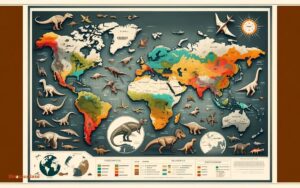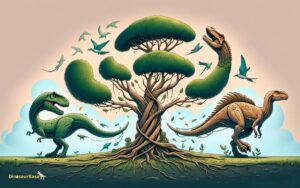Which Dinosaur Is Different
In the vast prehistoric tapestry where dinosaurs reign supreme, the Therizinosaurus stands out as a stitch of unique design. This enigmatic creature, with its long, scythe-like claws and a body that contradicts the typical predatory build, invites curiosity and speculation.
It's not just its appearance that sets it apart; the Therizinosaurus's lifestyle and diet challenge what one might expect from such a formidable figure. Among the giants that roamed the earth, why does this particular dinosaur defy the norms, and what secrets does it hold about life millions of years ago?
The answer may reshape our understanding of these ancient behemoths.
Key Takeaways
- The Ankylosaurus stands out with its armored body and club-like tail for defense.
- Therizinosaurus' vegetarian diet contrasts with the carnivorous nature of most theropods.
- Spinosaurus is unique for its aquatic adaptations and swimming abilities.
- Microraptor's four-winged anatomy sets it apart in flight evolution studies.
The Feathered Mystery: Therizinosaurus
The Therizinosaurus, often distinguished by its massive, scythe-like claws, presents a unique enigma in the dinosaur world due to evidence suggesting it sported a coat of feathers. This revelation challenges traditional perceptions of dinosaur appearance and physiology. Unlike the reptilian scales commonly associated with these prehistoric creatures, the presence of feathers on Therizinosaurus hints at a more complex evolutionary narrative.
Its peculiar physical characteristics, including long neck, robust body, and notably those elongated claws, initially puzzled scientists. However, the feathered aspect suggests it might've had a closer relationship to birds than previously thought. This discovery not only underscores the diversity within the Theropod group but also contributes to the ongoing debate about the evolutionary transition from dinosaurs to birds. It's a testament to the dynamic, ever-changing understanding of prehistoric life.
Swimming Giants: Spinosaurus
Spinosaurus, known for its distinctive sail-like fin and aquatic adaptations, challenges traditional views on dinosaur habitats and lifestyles. This semi-aquatic behemoth displayed a unique blend of traits that set it apart from its terrestrial counterparts, suggesting a life spent largely in water.
- *Spinosaurus had elongated, crocodile-like jaws and conical teeth, ideal for catching fish.*
- *Its dense bones, similar to those of modern aquatic animals, helped with buoyancy control.*
- *The sail-like structure on its back remains a topic of debate, with theories ranging from heat regulation to display functions.*
- *Fossil evidence suggests Spinosaurus could swim, making it one of the few known swimming dinosaurs.*
Analyzing Spinosaurus's features reveals a dinosaur adapted to a life both in and out of water, expanding our understanding of dinosaur diversity and ecology.
The Tiny Titan: Microraptor
How did Microraptor, a diminutive feathered dinosaur, challenge our understanding of flight evolution and dino-bird connections with its unique four-winged design?
This creature, barely larger than a modern crow, boasted feathers on both its arms and legs, presenting a form unlike any other known dinosaur. Its anatomy suggests a complex mode of aerial locomotion, perhaps gliding or even powered flight, bridging an evolutionary gap between non-avian dinosaurs and birds.
The discovery of Microraptor in the early 21st century provided compelling evidence of the diversity in flight adaptations among theropods, underscoring the evolutionary experimentation that occurred before the dominance of the avian flight model we see in birds today. Its existence prompts a reevaluation of how flight may have evolved multiple times in various lineages, highlighting the evolutionary ingenuity of nature.
Vegetarian Theropod: Therizinosaurus
Shifting focus from the aerial capabilities of Microraptor, we encounter Therizinosaurus, a theropod that defies traditional carnivorous expectations by adopting a vegetarian diet. Unlike its ferocious relatives, this dinosaur presents an intriguing anomaly within the theropod group.
- Massive Claws: Therizinosaurus boasted the longest claws of any known dinosaur, reaching up to 3 feet in length, primarily used for vegetation gathering.
- Late Cretaceous Era: It roamed the Earth around 70 million years ago, coexisting with other unique species.
- Distinct Body Structure: Its physique combined a bulky body, long neck, and beak-like mouth, optimized for a herbivorous lifestyle.
- Asia: Fossils have been predominantly discovered in Mongolia, indicating its habitat within lush ancient ecosystems.
Bizarre Armored Beast: Ankylosaurus
Ankylosaurus, known for its heavily armored body and club-like tail, represents a stark contrast to the other dinosaurs of its era, embodying the ultimate defense mechanism in the Late Cretaceous period.
It's not just the physical attributes that set Ankylosaurus apart; its survival strategy was fundamentally different. While many dinosaurs relied on speed or size, Ankylosaurus' evolution took a distinctive path towards armor and defense.
Its body was covered in thick, bony plates and spikes, offering protection against predators. The tail club, a unique feature among dinosaurs, served as a powerful weapon against any threat.
This combination of armor and weaponry made Ankylosaurus a formidable opponent and highlights its unique adaptation to the challenges of its environment.
Conclusion
In the prehistoric tapestry, Therizinosaurus stands out as a unique thread, weaving an intriguing pattern among its peers. Unlike the aquatic prowess of Spinosaurus, the diminutive might of Microraptor, or the armored fortress that's Ankylosaurus, Therizinosaurus blends the lines, being a vegetarian in a class dominated by carnivores.
Its enigmatic nature, adorned with massive claws, highlights nature's penchant for surprises, proving that evolution's canvas is broader and more vibrant than one might initially perceive.





